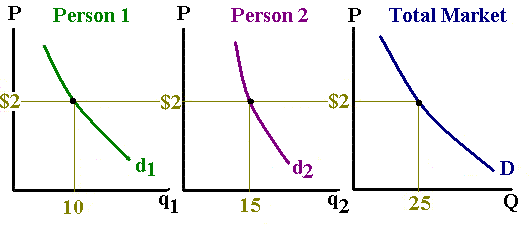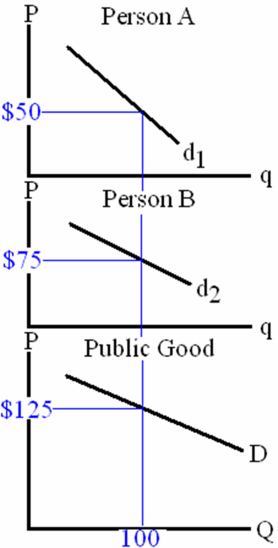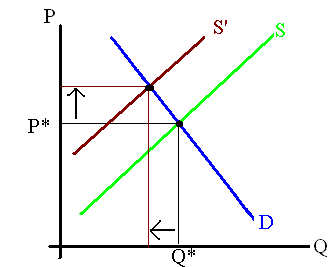|
Market Failure and
Government Intervention |
Private goods - goods supplied by producers in private sector
- Characteristics
- Rivalry - if one person buys
and consumes a product, then another cannot buy and consume that
product
- If a person buys and drinks a Coca-cola, then another customer cannot consume that Coca-cola.
- Excludable - producers can
restrict consumption of their product to consumers who paid for it.
- A store can restrict its sell of Coca-cola to a paying customers.
- Rivalry - if one person buys
and consumes a product, then another cannot buy and consume that
product
- Two people are in the market.
- Each person has their demand function.
- The quantity denoted by q is for a person, while Q is the total market quantity.
- Likewise, demand by a consumer is denoted by d, while market demand is D.
- Market demand - at each market price, horizontally sum the quantity that each consumer buys.

- Public Good - government produces
good, because firms have difficulty supplying good through the market.
- Two conditions:
- Nonrivalry - every one can consume the good at the same time
- Nonexcludable - the good cannot be restricted to the customers who pay for it
- Payment is not linked to consumption of good
- Free riders - person has no
incentive to pay for public goods
- Free riders will consume public good, but not help pay for it
- Examples:
- National defense (military)
- Radio and television broadcast signals (FCC)
- Clean air (EPA)
- Stable monetary and financial environment
- Federal Reserve System, i.e. central bank - influences inflation, interest, and foreign exchange rates
- Quasi-public goods - market
could supply these goods, but the supply would not be enough
- Highways
- Libraries
- Education
- Sewage disposal
- Postal service
- Two conditions:
- Could be perverse market conditions for public goods if supplied by
private market
- Rome had no fire department around 115 B.C.
- Marcus Licinus Crassus - started a private fire department in Rome
- As a person house was burning down, Crassus would be negotiating a price for his services
- Crassus had market power
- One of the wealthiest Roman citizens
- Lindahl Price - a way to
theoretically correct the market failure for public good
- If we could ask people the price they would be willing to pay for public good
- Then government charges each person his price (i.e. tax)
- However, free riders may not truthfully reveal their preferences
or willingness to pay
- Not practical
- For example, if government supplies 100 units of a public good
- If people truthfully reveal willingness to pay
- Person A pays $50 for these units
- Person B pays $75 for these units
- Total price is $125 for public good
- If people truthfully reveal willingness to pay

Cost-Benefit Analysis
- Government should use cost-benefit analysis to evaluate public
projects or goods
- Marginal benefit (MB) - the
additional amount society benefits, if government supplies one more
unit of a resource.
- This is the total demand for Lindahl price
- Negative slope
- Usually I drop MB and use D for demand for public goods
- Marginal cost (MC) - the
increase in cost to society, if government supplies one more unit of a
resource
- Positive slope
- This is the supply for a public good
- Usually government assesses taxes on society to finance projects
- Marginal benefit (MB) - the
additional amount society benefits, if government supplies one more
unit of a resource.
- Government maximizes society's return to a public good when MB = MC
- If MB > MC, government should increase one more unit of a public good
- If MB < MC, government should decrease a public good by one unit
- Example
- Government builds a new highway
- Benefits
- Businesses and people benefit from the highway if people use it.
- Relieves congestion from surrounding roads and highways
- Creates construction jobs
- Costs
- Government pays construction companies to build highway
- Government has to assess taxes
- Opportunity costs
- Land could be used for another activity
- Construction companies could build something else
- Benefits
- Government builds a new highway
| Cost-benefit analysis for public projects can be complicated.
Easy to manipulate numbers. Government does not have to maximize society's well being. Another strategy is to maximize its finances. Maximize tax revenues and minimize government expenditures. |
1. Negative externality - an individual's or firm's action harms others without their consent
- Property rights are not defined well
- Not all costs are registered, therefore supply function understates the true cost of production
- Example: Pollution
2. Open access property - property owned by society or the absence of ownership.
- Outsiders cannot be excluded from using the property.
- Also called the Tragedy of the Commons.
- People have less incentive to develop, improve, or maintain land, if others cannot be excluded from consuming it.
- Examples
- Fishermen over fish in public waters. Fishermen catch too many fish, causing fish populations to decrease to such a level that hurts future fish catching.
- Companies dump wastes onto public lands or waters.
- Air can be an open access resource. Some firms pollute and send pollution into the air
3. Fixing negative externalities (some also work for open access
property)
(i) Coase Theorem -
disputing parties will work out a private agreement that is efficient
- Polluting firms and the people that are harmed by the pollution can
negotiate to reduce pollution.
- Named after Noble laureate Ronald Coase (1960)
- Does not depend which party holds the property right.
- Example - a firm dumps pollution into a lake that kills the fish.
- If the right to use the lake is given to the fishermen, then the polluting firm has to negotiate and compensate fisherman in order to pollute the lake
- If the right is given to the polluting firm, then the fishermen will pay the firm not to pollute the lake.
- Benefit
- Could work for small group of people
- Private parties solve a pollution problem without the government’s help.
- Problems.
- Large groups of people have difficulty to agree about something.
- Coase Theorem requires all parties have perfect knowledge and zero transaction costs.
- Property rights are well defined
- A court system enforces contracts freely.
(ii) Lawsuits - U.S. has a variety of laws that allow people to sue to address externalities
- If firms know that they are creating negative externalities, they reduce negative externalities to reduce likelihood of being sued
- Problems
- Large legal fees and damage awards
- Courts are slow
- Some firms left the United States and relocated to countries with less harsh environmental laws
(iii) Government regulation of externalities (or open access)
- Command-and-control regulations
- government uses laws and regulations that dictate the standards and
technology used to reduce pollution.
- Government imposes the technology and machines that an industry uses.
- Government fines and penalizes companies that violate the rules.
- Example - U.S. government requires electric power companies to install “scrubbers” to clean power plant emissions.
- Example - Clean Air Act of 1990
- Gives EPA the authority to regulate 189 toxic chemicals
- EPA specifies mandates how businesses and companies lower pollution
- Example - U.S. government banned production of chlorofluorocarbons
(CFCs)
- CFCs deplete the ozone layer, allowing more radiation to enter atmosphere
- CFCs are used as refrigerants in refrigerators and air conditioning units
- Benefits - government easily enforces the rules.
- Problems - regulations limit a firm’s flexibility and freezes
technology.
- Firms may not produce at minimum costs
- Market incentives - government
uses price and quantity mechanisms to internalize the externalities.
- Price incentives
- Pollution taxes - puts a price on pollution
- A firm supplies Q* which sell for P* and freely pollutes
- Pollution is a social cost to society
- Government implements a tax on pollution, which puts a price on pollution
- Equilibrium price increases while quantity supplied decreases
- This is efficient because firm pays all costs including pollution
- Firms still pollute, but less
- Firms can pay the tax on pollution or avoid the tax by reducing pollution
- Pollution taxes - puts a price on pollution
- Price incentives

- Examples
- Electric generation plants that use coal to generate electricity
- Some coal has sulfur that turns into sulfur dioxide when burned
- Leads to acid rain
- Sulfur dioxide permits
- Proposing a permit system for mercury emission and greenhouse gases
- Pollution permits - puts a limit on amount of pollution a firm can
produce
- Polluting firms in market are given pollution permits
- Market incentives give firms more flexibility
- Some firms will invest in technology to reduce pollution
- Firms could sell their permits to other polluting firms
- Some firms will choose to pollute and buy the permits
- Firms may meet pollution objectives with lower costs.
- Pollution is a property right
- Permits put a price on pollution
- Some firms will invest in technology to reduce pollution
- Problem - market incentives may impose higher enforcement costs on government.
4. Positive externality - an individual's actions generate benefits for nonparticipating parties
- Demand functions understates the true value of output
- The private market may not supply enough
- Example - inoculation for diseases
- Each person who gets an inoculation can prevent spread of a disease
- Fixing positive externality
- Subsidies - government
provides subsidies so producers will supply more
- Example - government grants subsidies to producers of vaccines
- Note - government could subsidize the consumer to take advantage of the externality
- Government provides the good
- Health departments give vaccines to the poor and elderly
- Subsidies - government
provides subsidies so producers will supply more
5. Global warming - greenhouse gases are accumulating in the atmosphere, causing the world to become warmer
- Problems
- Ocean levels become higher, so coastal cities will disappear
- Various species may become extinct
- More extreme weather events
- Greenhouse gases
- Carbon dioxide
- Sources - fossil fuels, animals, humans, etc.
- Sinks - plants
- Methane
- Sources - industries, cattle, swamps, etc.
- Nitrous oxide
- Water vapor - not disclosed very often
- Carbon dioxide
- Theory
- Earth is experiencing a warming trend
- Are greenhouse gases causing the world to be warmer or is this one of the earth's cycles?
- Already lawsuits
- One lawsuit forces the EPA to add carbon dioxide on to the list of pollutants
- Congress is talking about a permit system
- Governments at all levels in U.S. are placing restrictions on new factories
- Trivial
- What percentage of (dry) air is composed of carbon dioxide?
- 78.08% nitrogen
- 20.95% oxygen
- 0.93% argon
- 0.038% carbon dioxide
- What percentage of (dry) air is composed of carbon dioxide?
- Asymmetric information - either the buyer or seller has more information than the other side
- Market may undersupply goods with severe asymmetric information problems
- Examples:
- Credit card companies - calculating interest rates
- Difficult to inspect good or seldom purchases the good from the same producer
- Some firms will provide:
- low-quality
- defective
- even harmful goods
- Moral hazard - one of the
parties to a contract change their behavior that imposes a cost on the
other party
- A person gets car insurance and drives more crazy
- A person gets theft insurance for his apartment and he leave the door unlock
- Government insures bank deposits through FDIC
- Banks may lend to more risky borrowers, because their depositors are protected from deposit insurance.
- Financial institutions may invest in more risky assets, if they are certain government will bail them out.
- Adverse selection - one of the
parties to a transaction withholds critical information
- Usually people who buy insurance plan to use it
- Person gets health insurance, knowing he has a medical condition
- Person hires an arsonist to burn his business down after getting fire insurance
- A person buys fire insurance, knowing he faulty wiring in his home
- A person gets a credit card, knowing he will not make payments on it.
- Government intervention
- Some forms may be illegal and prosecuted by government
- Weights and measures - government has inspectors that make sure
gas pumps and supermarket scales are accurate
- Are you sure you if you pumped one gallon and it is truly one gallon
- Government sues producers that make false claims
- Regulations - government approves new products and has inspectors
that inspect products
- Example - USDA has inspectors that frequently inspects meats
- Licenses - ensures professionals have a high level of competency
- Professionals like doctors, lawyers, mechanics, etc. need licenses to practice
- Private market
- Purchasing good regularly
- Brand name
- Franchises
- Product warranties
- Public information - Consumer Reports - magazine that examines consumer products
- Databases - companies compile information about customers
- Credit Bureaus - Experian, Equifax, and TransUnion
- Banks use ChexSystems
|
|